Mothra Blu-ray Movie
HomeMothra Blu-ray Movie 
モスラ / MosuraMill Creek Entertainment | 1961 | 1 Movie, 2 Cuts | 101 min | Not rated | Jul 09, 2019
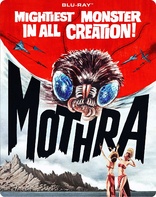
Movie rating
7.2 | / 10 |
Blu-ray rating
| Users | 4.0 | |
| Reviewer | 3.0 | |
| Overall | 3.0 |
Overview
Mothra (1961)
Two six-inch twins, kept captive by an evil sideshow owner, pray to their god Mothra to save them. What comes out is a giant mothlike creature which inadvertently weaves a path of destruction over Tokyo on the way to its rescue mission.
Starring: Hiroshi Koizumi, Kyôko Kagawa, Yűmi Itô, Emi Itô (III), Ken UeharaDirector: Ishiro Honda
| Foreign | Uncertain |
| Sci-Fi | Uncertain |
| Supernatural | Uncertain |
| Fantasy | Uncertain |
| Adventure | Uncertain |
| Drama | Uncertain |
| Family | Uncertain |
| Action | Uncertain |
| Mystery | Uncertain |
Specifications
Video
Video codec: MPEG-4 AVC
Video resolution: 1080p
Aspect ratio: 2.35:1
Original aspect ratio: 2.35:1
Audio
Japanese: DTS-HD Master Audio Mono
English: DTS-HD Master Audio 2.0 Mono
Subtitles
English, English SDH
Discs
Blu-ray Disc
Single disc (1 BD)
Packaging
Slipcover in original pressing
Playback
Region free
Review
Rating summary
| Movie | 3.5 | |
| Video | 4.0 | |
| Audio | 2.5 | |
| Extras | 2.0 | |
| Overall | 3.0 |
Mothra Blu-ray Movie Review
Reviewed by Martin Liebman July 10, 2019Mill Creek has released 1961’s Kaiju film ‘Mothra’ to Blu-ray in collectible SteelBook packaging. The SteelBook offers attractive artwork and the on-disc content is quite good, particularly considering Mill Creek’s aggressive pricing. Find below a brief film review as well as full Blu-ray video and audio reviews. See the ‘Special Features and Extras’ section of this review below for a review of the SteelBook’s look and feel.
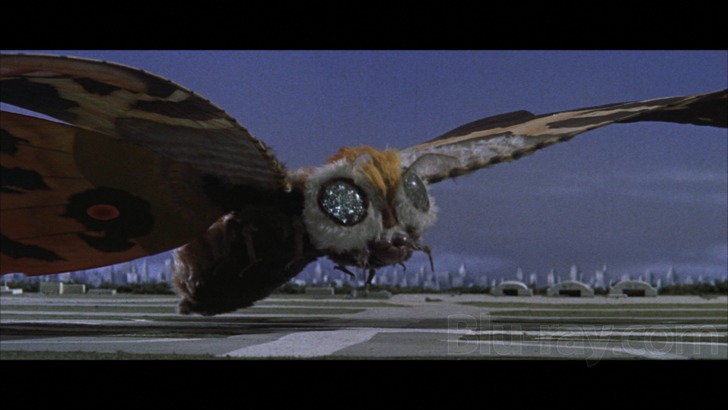
A powerful typhoon is approaching the Japanese mainland. In the storm, a ship runs aground on an island once used as a nuclear testing site. Four crew members are rescued and it is discovered that the men are suffering no ill effects from radiation exposure; they state that the island's “natives” -- “sacred beauties of a lost tribe” as they are called -- gave them healing juice to drink, but the island is supposed to be deserted. This results in an expedition to the island where two of the pint-sized girls are forcibly taken back to the mainland and forced into servitude as show attractions. But the kidnapped girls, and their friends back on the island, call to the ancient insect Mothra to save them, an extremely large creature that will stop at nothing to rescue those it has long been charged with protecting.
Mothra is a fun film comfortable in genre and content with type. The story is a bit flimsy as a result but it's certainly one of the more unique tales in the Kaiju universe with quasi-religious overtones and a couple of unforgettably unique characters in the twin girls played by real-life singing sensations Yumi and Emi Ito, better known as "The Peanuts." Characters are by-and-large otherwise stock but enthusiastically performed. Model and wire work are obvious -- particularly on Blu-ray -- but add to the inherent charm that is absent in today's larger and louder digital spectacles. Mothra would later appear in several Kaiju films and is the most frequently seen star behind, of course, Godzilla.
Mothra Blu-ray Movie, Video Quality 
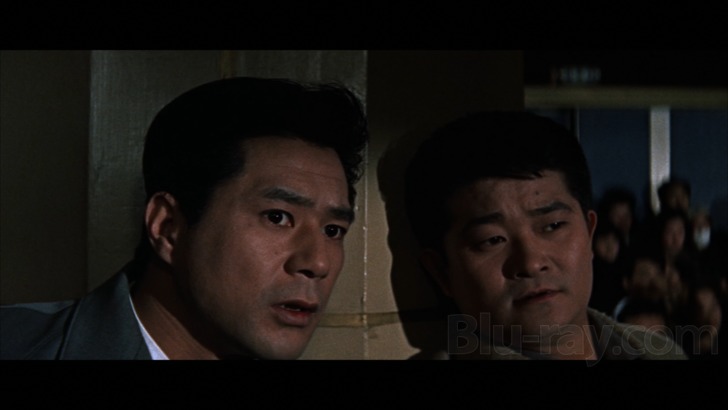
On the English version, opening title wobble is rather severe. Stray vertical lines are not entirely uncommon, and various pops and speckles appear throughout. But none of these issues are particularly problematic on the macro level. The picture generally finds, and maintains, a handsome, filmic, authentic appearance. Optical effects shots are of course a little softer but the image proper is quite nice, for the most part, maintaining a healthy grain structure, quality textural visibility, and finessed detail nuance. Clothes and faces are nicely revealing. Environments are smartly detailed, as are both to-scale props and various miniatures, such as cars and tanks. Rich blue skies are amongst the color highlights, particularly in a shot as the men arrive on the island in the 19-minute mark, contrasted against gray rocks and boring beige radiation suits. Explosions, tracer gun fire, and other more distinguished colors are impressive, but the palette never consistently pops with any serious intensity. It's well-rounded and very workable, particularly on the island where some dense natural greens and colorful flora produce near stunning result. The Japanese cut is very similar if not identical; there are no glaring technical differences of note.
Mothra Blu-ray Movie, Audio Quality 
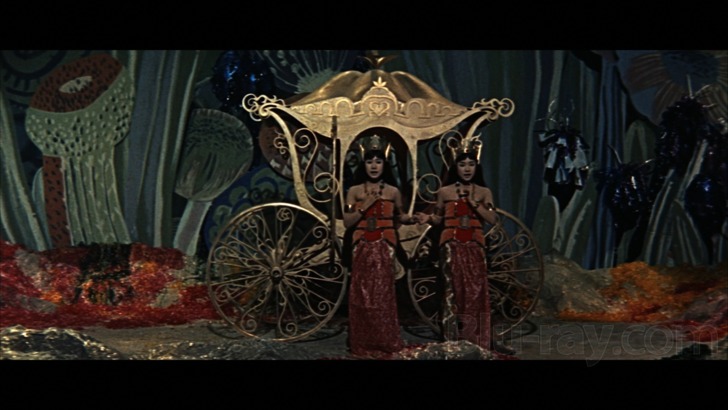
The English version's DTS-HD Master Audio 2.0 dubbed soundtrack is very minimalistic, crunchy, and imprecise. Crashing waves, gusting wind, and driving rain in the opening minutes fail to reproduce anything but a shrilly sound, focused in the center with very little feel for spread. Music is crunchy and plays as more of a background element than major audio component. Gunfire in chapter six is disappointingly lacking in density and detail, as are the thunder, musical notes, and falling rocks to follow, which merge into a jumble of tinny, harsh sounds. Ditto the various third act action scenes. The Japanese track is equally imprecise, lacking intensity and clarity and width at all the same junctures. It is the preferred version for authenticity, though the English dub is certainly proficient. White English subtitles accompany the Japanese feature but do bleed slightly into the widescreen "black bars."
Mothra Blu-ray Movie, Special Features and Extras 
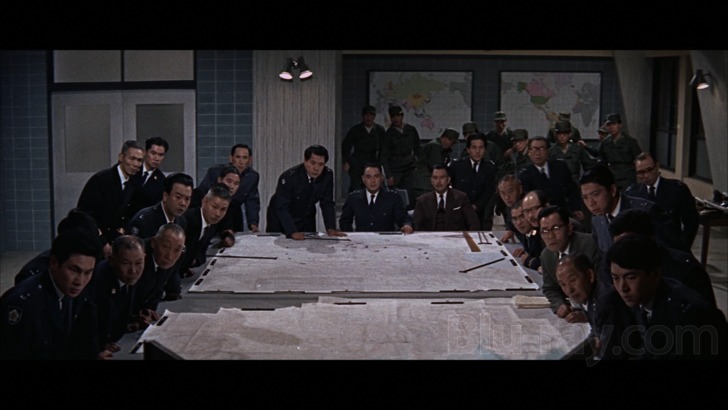
Mothra's wide release SteelBook makes for handsome addition to any SteelBook collection, film library, or both. The front cover depicts the
title character's (evolved) head, center, peeking out above what appears to be a large white sheet, which could also loosely be interpreted as a densely
cloudy
white sky. Either way the film's title stylistically spreads across its length, which at least in part gives the illusion of a wingspan. A mountainous
formation appears at the bottom from the radioactive island that features prominently in the film. Above Mothra at the top is a solid red color, broken
up only by the creature's antennae. The red color and the creature's blue eyes are a little reflective or metallic looking. It's a very handsome effect. The
rear side is busy, depicting Mothra flying over the city against a metallic silvery sky. The creature in its original caterpillar form appears center against
one of the vehicle mounted atomic ray guns used against it. The creature hatching from the egg appears bottom center. A SteelBook logo and website
appear unobtrusively in silver color bottom left. The black lettering on the front will attract fingerprints, but not severely. The spine carries over the
front's red reflective/metallic coloring. The film's title appears in the same stylized letters as the front but in white
color. Mill Creek and Blu-ray logos appear at the bottom. It's a great looking outer
shell.
Inside, there is no digital copy and only one disc, which is situated on a center hub on the right-hand side. The inner print is comprised of a two-panel
spread that depicts a key scene from the film recreated in drawing, featuring several scientists in radiation suits examining the two "sacred beauties of
the lost tribe" who will eventually be kidnapped and call out to their savior, Mothra.
This SteelBook ships with a transparent plastic slipcover that has on it printed essentials on the front and rear sides: "Mightiest Monster In All Creation"
text and a few images (the girls pointing up to Mothra from the bottom right, missiles raining down on it from the top left and right sides) on the front
and a more involved cluster of information including a
barcode, plot summary, film images, bonus feature listings, a billing block, and some
Blu-ray tech spec boxes. It's a more attractive alternative to the traditional, more flimsy and ultimately disposable, "J-Card" that is glued to
most SteelBook
releases.
See and scroll through the "Screenshots" tab above for several photographs of the
SteelBook.
On the disc, two cuts of the film are included: the Japanese Version (1:40:51) and the English Version (1:30:11). Supplementally, the following extras
are included:
- English Version Audio Commentary: Steve Ryfle and Ed Godziszewski, authors of the Ishirō Honda biography Ishiro Honda: A Life in Film, from Godzilla to Kurosawa, man the track. They are able to offer a more unique perspective away from the usual commentary fodder, detailing the movie away from the usual making-of, on-set content and share a number of more fruitful project insights and film history in retrospective. It's clear they are reading their comments rather than chatting organically, but it is a well-versed track that finds detail in story, characters, actors, anecdotes, and the film's place in cinema and Kaiju history.
- Teaser (480i, 1:25).
- Trailer (720p, 1:55).
- Image Gallery (1080i): About 50 promotional images and posters.
Mothra Blu-ray Movie, Overall Score and Recommendation 
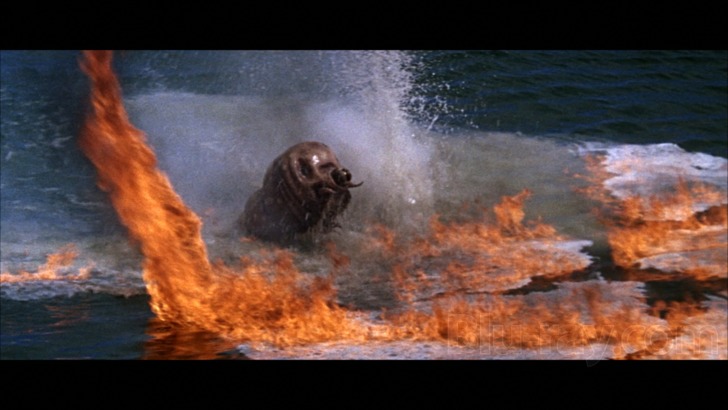
Mothra is described in the commentary track as a "lavish production with an all-star cast" and a film with "fantasy elements and a feminine feel." It's certainly a departure from some of the other films in the Godzilla universe, though it does share some of the same essential characteristics. It's certainly a necessary watch for those coming into the franchise via Godzilla: King of the Monsters, in which Mothra plays a critical part. Mill Creek's SteelBook release is of a good quality; the on-disc content is quite good, lacking only a higher yield soundtrack. Highly recommended.
Similar titles
Similar titles you might also like

Mothra vs. Godzilla
モスラ対ゴジラ / Mosura tai Gojira
1964

Gamera the Brave
2006

Gamera: Guardian of the Universe
Gamera daikaijű kuchu kessen
1995

Gamera
Daikaijű Gamera / Gamera, the Giant Monster
1965

Godzilla vs. Megaguirus
ゴジラ × メガギラス G消滅作戦 / Gojira tai Megagirasu: Jî shômetsu sakusen
2000

Godzilla vs. SpaceGodzilla
ゴジラvsスペースゴジラ / Gojira vs. Supesugojira
1994

Godzilla: Final Wars
ゴジラ ファイナルウォーズ / Gojira: Fainaru uôzu
2004

Godzilla, Mothra and King Ghidorah: Giant Monsters All-Out Attack
ゴジラ・モスラ・キングギドラ 大怪獣総攻撃 / Gojira, Mosura, Kingu Gidorâ: Daikaijű sôkôgeki
2001

Godzilla vs. Destoroyah
ゴジラvsデストロイア / Gojira vs. Desutoroiâ / Godzilla vs. Destroyer
1995

Godzilla 2000
ゴジラ2000 ミレニアム / Gojira ni-sen mireniamu / Godzilla 2000: Millennium
1999

Gamera 3: Revenge of Iris
1999

Godzilla and Mothra: The Battle for Earth
ゴジラvsモスラ / Gojira vs. Mosura / Godzilla vs. Mothra
1992

Godzilla 1984
ゴジラ / Gojira / The Return of Godzilla
1984

Gamera vs. Viras
Gamera tai uchu kaijű Bairasu / Destroy All Planets
1968

Gamera vs. Barugon
Daikaijű kettô: Gamera tai Barugon
1966

Gamera vs. Gyaos
Daikaijű kűchűsen: Gamera tai Gyaosu
1967

Gamera vs. Guiron
Gamera tai daiakuju Giron
1969

Gamera vs. Jiger
Gamera tai Daimaju Jaiga
1970

Godzilla vs. King Ghidorah
ゴジラvsキングギドラ / Gojira vs. Kingu Gidorâ
1991

Godzilla vs. Mechagodzilla II
ゴジラvsメカゴジラ / Gojira vs. Mekagojira
1993